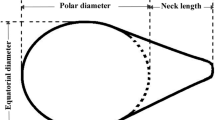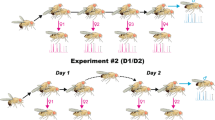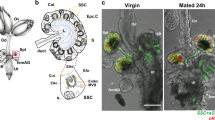Summary
Explosive spermatozoid release inLaminaria digitata is triggered by a pheromone secreted by female gametes. Dependence of the pheromone action on extracellular cations was investigated in defined test media using a pure pheromone preparation. The experimental results indicate successive processes in the sensory system and are summarized in a hypothesis on the release mechanism. The polysaccharide composition of the antheridial cell wall and the mucilage surrounding the spermatozoid was identified by cytochemical methods.
Similar content being viewed by others
References
Bentrup, F. W., 1979: Reception and transduction of electrical and mechanical stimuli. In: Physiology of movements. Encyclopedia of plant physiology N. S. 7 (Haupt, W., Feinleib, M. E., eds.). Berlin-Heidelberg-New York: Springer.
Boland, W., Jakoby, K., Jaenicke, L., Müller, D. G., Fölster, E., 1981 a: Receptor specificity and threshold concentration in chemotaxis of the phaeophyteCutleria multifida. Z. Naturforsch.36 c, 262–271.
—,Jaenicke, L., Müller, D. G., 1981 b: Synthese und biologische Aktivitäten von (+)- und (−)-Multifiden. Liebigs Ann. Chem.1981, 2266–2271.
Boney, A. D., 1981: Mucilage: The ubiquitous algal attribute. Brit. phycol. J.16, 115–132.
Hille, B., 1971: The permeability of the sodium channel to organic cations in myelinated nerve. J. gen. Physiol.58, 599–619.
Hope, A. B., Walker, N. A., 1975: The physiology of giant algal cells. London: Cambridge University Press.
Hotchkiss, R. D., 1948: A microchemical reaction resulting in the staining of polysaccharide structures in fixed tissue preparations. Arch. Biochem.16, 131–141.
Jaenicke, L., Müller, D. G., Moore, R. E., 1974: Multifidene and aucantene, C11 hydrocarbons in the male-attracting essential oil from the gynogametes ofCutleria multifida (Smith) Grev. (Phaeophyta). J. Amer. chem. Soc.96, 3324–3325.
—,Waffenschmidt, S., 1981: Liberation of reproductive units inVolvox andChlamydomonas: proteolytic processes. Ber. dtsch. bot. Ges.94, 375–386.
Kantor, T. G., Schubert, M., 1957: A method for the desulfation of chondroitin sulfate. J. Amer. chem. Soc.79, 152–153.
Karlson, P., Lüscher, M., 1959: Pheromones: a new term for a class of biologically active substances. Nature183, 55–56.
Loiseaux, S., 1973: Ultrastructure of zoidogenesis in unilocular zoidocysts of several brown algae. J. Phycol.9, 277–289.
Luft, J. H., 1971: Ruthenium red and violet. I. Chemistry, purification, methods of use for electron microscopy and mechanism of action. Anat. Rec.171, 347–368.
Lüning, K., 1980: Critical levels of light and temperature regulating the gametogenesis of threeLaminaria species (Phaeophyceae). J. Phycol.16, 1–15.
—,Dring, M. J., 1975: Reproduction, growth and photosynthesis of gametophytes ofLaminaria saccharina grown in blue and red light. Mar. Biol.29, 195–200.
—,Müller, D. G., 1978: Chemical interaction in sexual reproduction of severalLaminariales (Phaeophyceae): release and attraction of spermatozoids. Z. Pflanzenphysiol.89, 333–341.
Maier, I., Müller, D. G., 1982: Antheridium fine structure and spermatozoid release inLaminaria digitata (Phaeophyceae). Phycologia21, 1–8.
Moore, C. L., 1971: Specific inhibition of mitochondrial Ca2− transport by ruthenium red. Biochem. Biophys. Res. Commun.42, 298–305.
Müller, D. G., Jaenicke, L., Donike, M., Akintobi, T., 1971: Sex attractant in a brown alga: chemical structure. Science (Wash.)171, 815–817.
—,Jaenicke, L., 1973: Fucoserraten, the female sex attractant ofFucus serratus L. (Phaeophyta). FEBS Lett.30, 137–139.
—,Gassmann, G., Lüning, K., 1979: Isolation of a spermatozoidreleasing and -attracting substance from female gametophytes ofLaminaria digitata. Nature (Lond.)279, 430–431.
—,Gassmann, G., 1980: Sexual hormone specificity inEctocarpus andLaminaria (Phaeophyceae). Naturwissenschaften67, 462.
—,Gassmann, G., Boland, W., Marner, F., Jaenicke, L., 1981:Dictyota dichotoma (Phaeophyceae): Identification of the sperm attractant. Science (Wash.)212, 1040–1041.
—,Lüthe, N. M., 1981: Hormonal interaction in sexual reproduction ofDesmarestia aculeata (Phaeophyceae). Brit. phycol. J.16, 351–356.
—,Gassmann, G., Peters, A., Boland, W., Marner, F., Jaenicke, L., 1982: Identification of a sexual hormone and related substances in the marine brown algaDesmarestia. Naturwissenschaften69, 290.
Narahashi, T., 1974: Chemicals as tools in the study of excitable membranes. Physiol. Rev.54, 813–889.
Pearse, A. G. E., 1968: Histochemistry. Theoretical and applied. Vol. 1, 3rd Ed., pp. 330–337. London: J. & A. Churchill Ltd.
Percival, E., McDowell, R. H., 1967: Chemistry and enzymology of marine algal polysaccharides. London-New York: Academic Press.
Rasmussen, H., 1970: Cell communication, calcium ion, and cyclic adenosine monophosphate. Science (Wash.)170, 404–412.
Schlösser, U. G., 1976: Entwicklungsstadien- und sippenspezifische Zellwand-Autolysine bei der Freisetzung von Fortpflanzungszellen in der GattungChlamydomonas. Ber. dtsch. bot. Ges.89, 1–56.
Spicer, S. S., Lillie, R. D., 1959: Saponification as a means of selectively reversing the methylation blockade of tissue basophilia. J. Histochem. Cytochem.7, 123–125.
Spurr, A. R., 1969: A low-viscosity epoxy resin embedding medium for electron microscopy. J. Ultrastruct. Res.26, 31–43.
Starr, R. C., 1978: The culture collection of algae at the University of Texas at Austin. J. Phycol.14 suppl., 47–100.
Toth, R., 1976 a: A mechanism of propagule release from unilocular reproductive structure in brown algae. Protoplasma89, 263–278.
—, 1976 b: The release, settlement and germination of zoospores inChorda tomentosa (Phaeophyceae, Laminariales). J. Phycol.12, 222–233.
Touet, G., Aach, H. G., 1979: Isolation and first characterization of a cell-wall-degrading agent ofChlorella. Naturwissenschaften66, 525.
Weiss, G. B., 1974: Cellular pharmacology of lanthanum. Annu. Rev. Pharmacol.14, 343–354.
Author information
Authors and Affiliations
Rights and permissions
About this article
Cite this article
Maier, I. New aspects of pheromone-triggered spermatozoid release inLaminaria digitata (Phaeophyta) . Protoplasma 113, 137–143 (1982). https://doi.org/10.1007/BF01282003
Received:
Accepted:
Issue Date:
DOI: https://doi.org/10.1007/BF01282003




